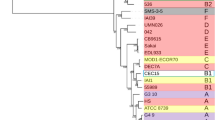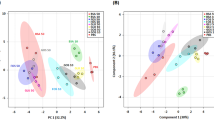Abstract
Enterococcus (E.) faecalis is found as commensal in healthy humans, in a variety of fermented foods. It can serve as probiotic but also as pathogen causing endocarditis, bacteremia and urinary tract infections. We have employed a proteomic study with E. faecalis strain OG1RF under different growth conditions and in contact to mouse intestinal cells to identify novel latent and adaptive fitness determinants. These relate to changes in catabolic pathways (BudA), protein biosynthesis (AsnS), cellular surface biosynthesis (RmlA) and regulatory mechanisms (OmpR). This knowledge can be used to derive novel evidence-based targets, which can be used to further elucidate gene expression changes enhancing pathogenicity or fitness in a commensal strain and possibly delineate this species into groups of higher and lower risk for applications in a food or a medical context versus improved treatment strategies of the so far hard to cure diseases.
Similar content being viewed by others
References
Altschul SF, Gish W, Miller W, Myers EW, Lipman DJ (1990) Basic local alignment search tool. J Mol Biol 215:403–410
Barcelona-Andrés B, Marina A, Rubio V (2002) Gene structure, organization, expression, and potential regulatory mechanisms of arginine catabolism in Enterococcus faecalis. J Bacteriol 184:6289–6300
Behr J, Israel L, Gänzle MG, Vogel RF (2007) Proteomic approach for characterization of hop-inducible proteins in Lactobacillus brevis. Appl Environ Microbiol 73:330–3306
Blum H, Beier H, Gross HJ (1987) Improved silver staining of plant proteins, RNA and DNA in polyacrylamide gels. Electrophoresis 8:93–99
Boehle LA, Frægestad EM, Veiseth-Kent E, Steinmoen H, Nes I, Eisink V, Geir M (2010) Identification of proteins related to the stress response in Enterococcus faecalis V583 caused by bovine bile. Proteome Sci 8:37
Bryan-Jones DG, Whittenbury R (1969) Haematin-dependent oxidative phosphorylation in Streptococcus faecalis. J Gen Microbiol 58:247–260
Centeno JA, Menendez S, Hermida M, Rodríguez-Otero JL (1999) Effects of the addition of Enterococcus faecalis on Cebreiro cheese manufacture. Int J Food Microbiol 48:97–111
Coburn PS, Pillar CM, Jett BD, Haas W, Gilmore MS (2004) Enterococcus faecalis senses target cells and in response expresses cytolysin. Science 306:2270–2272
Curic M, Stuer-Lauridsen B, Renault P, Nilsson D (1999) A general method for selection of alpha-acetolactate decarboxylase-deficient Lactococcus lactis mutants to improve diacetyl formation. Appl Environ Microbiol 65:1202–1206
Dolin MI, Gunsalus IC (1951) Pyruvic acid metabolism II. An acetoin forming enzyme system in Streptococcus faecalis. J Bacteriol 62:199–214
Dubrac S, Msadek T (2004) Identification of genes controlled by the essential YycG/YycF two-component system of Staphylococcus aureus. J Bacteriol 186:1175–1181
Duez C, Zorzi W, Sapunaric F, Amoroso A, Tam I, Coyette J (2001) The penicillin resistance of Enterococcus faecalis JH2-2r results from an overproduction of the low-affinity penicillin-binding protein PBP4 and does not involve a psr-like gene. Microbiology 147:2561–2569
Dunny GM, Brown BL, Clewell DB (1978) Induced cell aggregation and mating in Streptococcus faecalis: evidence for bacterial sex pheromone. Proc Nat Acad Sci USA 75:3479–3483
Flahaut S, Hartke A, Giard JC, Benachour A, Boutibonnes P, Auffray Y (1996) Relationship between stress response toward bile salts, acid and heat treatment in Enterococcus faecalis. FEMS Microbiol Lett 138:49–54
Flahaut S, Hartke A, Giard JC, Auffray Y (1997) Alkaline stress response in Enterococcus faecalis: adaption, cross-protection, and changes on protein synthesis. Appl Environ Microbiol 63:812–814
Forrest WW (1965) Adenosine triphosphate pool during the growth cycle in Streptococcus faecalis. J Bacteriol 90:1013–1016
Frank A, Pevzner P (2005) PepNovo: De Novo peptide sequencing via probabilistic network modeling. Anal Chem 77:964–973
Frank A, Tanner S, Bafna V, Pevzner P (2005) Peptide sequence tags for fast database search in mass-spectrometry. J Prot Res 4:1287–1295
Frank AM, Savitski MM, Nielsen LM, Zubarev RA, Pevzner PA (2007) De Novo peptide sequencing and identification with precision mass spectrometry. J Prot Res 6:114–123
Freitas M, Cayuela C (2000) Microbial modulation of host intestinal glycosylation patterns. Microb Ecol Health Disease Suppl 2:165–178
Giard J-C, Rincé A, Capiaux H, Auffray Y, Hartke A (2000) Inactivation of the stress-and starvation-inducible gls24 operon has a pleiotropic effect on cell morphology, stress sensitivity, and gene expression in Enterococcus faecalis. J Bacteriol 16:4512–4520
Gold OG, Jordan HV, van Houte J (1975) The prevalence of enterococci in the human mouth and their pathogenicity in animal models. Arch Oral Biol 20:473–477
Görg A, Postel W, Weser J, Günther S, Strahler JR, Hanash SM, Somerlot L (1987) Elimination of point streaking on silver stained two-dimensional gels by addition of iodacetamide to the equilibration buffer. Electrophoresis 8:122–124
Görg A, Obermaier C, Boguth G, Harder A, Scheibe B, Wildgruber R, Weiss W (2000) The current state of two-dimensional electrophoresis with immobilized pH gradients. Electrophoresis 21:1037–1053
Haas W, Shepard BD, Gilmore MS (2002) Two-component regulator of Enterococcus faecalis cytolysin responds to quorumsensing autoinduction. Nature 415:84–87
Hanin A, Sava I, Bao YY, Huebner J, Hartke A, Auffray Y, Sauvageot N (2007) Screening of in vivo activated genes in Enterococcus faecalis during insect and mouse infections and growth in urine. PLoS ONE 5:e11879
Hartke A, Giard J-C, Laplace J-M, Auffray Y (1998) Survival of Enterococcus faecalis in an oligotrophic microsom: changes in morphology, development of general stress resistance, and analysis of protein synthesis. Appl Environ Microbiol 64:4238–4245
Hew CM, Korakli M, Vogel RF (2007) Expression of virulence-related genes by Enterococcus faecalis in response to different environments. System Appl Microbiol 30:257–267
Hulse MI, Smith S, Chi EY, Pham A, Rubens CE (1993) Effect of type III group streptococcal capsular polysaccharide on invasion of respiratory epithelial cells. Infect Immun 61:4831–4835
Jones ME, Lipmann F (1960) Chemical and enzymatic synthesis of carbamyl phosphate. Biochemistry 46:1194–1205
Lih-Brody L, Powell SR, Collier KP, Reddy GM, Cerchia R, Kahn E, Weissman GS, Katz S, Floyd RA, McKinley MJ, Fisher SE, Mullin GE (1996) Increased oxidative stress and decreased antioxidant defense in mucosa of inflammatory bowel disease. Digestive Diseases Sci 41:2078–2086
Lindenstrauß AG, Pavlovic M, Bringmann A, Behr J, Ehrmann MA, Vogel RF (2011) Comparison of genotypic and phenotypic cluster analyses of virulence determinants and possible role of CRISPR elements towards their incidence in Enterococcus faecalis and Enterococcus faecium. System Appl Microbiol 34:553–560
Lipinski S, Till A, Sina C, Arlt A, Grasberger H, Schreiber S, Rosenstiel P (2009) DUOX2-derived reactive oxygen species are effectors of NOD2-mediated antibacterial responses. J Cell Sci 122:3522–3530
Maekawa S, Habadera S (1996) Comparative distribution of the serotypes of Enterococcus faecalis isolated from the urine of patients with urinary tract infections and the feces of healthy persons as determined by the slide agglutination reaction. Kansenshogaku Zasshi 70:168–174
Marchesini B, Buttin A, Romailler N, Moreton RS, Stucchi C, Sozzi T (1992) Microbiological events during commercial meat fermentation. J Appl Microbiol 73:203–209
Marquis RE, Bender GR, Murray DR, Wong A (1987) Arginine deiminase system and bacterial adaptation to acid environments. Appl Environ Microbiol 53:198–200
Maury J, Bernadac A, Rigal A, Maroux S (1995) Expression and glycosylation of the filamentous brush border glycocalyx (FBBG) during rabbit enterocyte differentiation along the crypt-villus axis. J Cell Sci 108:2705–2713
Metaxopoulos J, Samelis J, Papaedlli M (2001) Technological and microbiological evaluation of traditional processes as modified for the industrial manufacturing of dry fermented sausages in Greece. Italian J Food Sci 13:3–18
Monnet C, Nardi M, Hols P, Gulea M, Corrieu G, Monnet V (2003) Regulation of branched-chain amino acid biosynthesis by alpha-acetolactate decarboxylase in Streptococcus thermophilus. Lett Appl Microbiol 36:399–405
Murray BE, Singh KV, Ross RP, Heath JD, Dunny GM, Weinstock GM (1993) Generation of restriction map of Enterococcus faecalis OG1 and investigation of growth requirements and regions encoding biosynthetic function. J Bacteriol 175:5216–5233
Nachin L, Loiseau L, Expert D, Barras F (2003) SufC: an unorthodox cytoplasmic ABC/ATPase required for [Fe-S] biogenesis under oxidative stress. EMBO J 22:427–437
Nallapareddy SR, Qin X, Weinstock GM, Hook M, Murray BE (2000) Enterococcus faecalis adhesion, ace, mediates attachment to extracellular matrix proteins collagen type IV and laminin as well as collagen type I. Infect Immun 68:5218–5224
Nallapareddy SR, Singh KV, Sillanpää J, Zhao M, Murray BE (2011) Relative contributions of Ebp pili and the collagen adhesin Ace to host extracellular matrix protein adherence and experimental urinary tract infection by Enterococcus faecalis OG1RF. Infect Immun 79:1910–2901
Nannini EC, Teng F, Singh KV, Murray BE (2005) Decreased virulence of a gls24 mutant of Enterococcus faecalis OG1RF in an experimental endocarditis model. Infect Immun 73:7772–7774
Nieto-Arribas P, Seseña S, Poveda JM, Chicón R, Cabezas L, Palop L (2001) Enterococcus populations in artisanal Manchego cheese: biodiversity, technological and safety aspects. Food Microbiol 28:891–899
Perkins DN, Pappin DJ, Creasy DM, Cottrell JS (1999) Probability-based protein identification by searching sequence databases using mass spectrometry data. Electrophoresis 20:3551–3567
Qin X, Singh KV, Weinstock GM, Murray BE (2000) Effects of Enterococcus faecalis fsr genes on production of gelatinase and a serine protease and virulence. Infect Immun 68:2579–2586
Riboldi GP, Verli H, Frazzon J (2009) Structural studies of the Enterococcus faecalis SufU [Fe-S] cluster protein. BMC Biochem 10:3
Shankar N, Lockatell CV, Baghdayan AS, Drachenberg C, Gilmore MS, Johnson ME (2001) Role of Enterococcus faecalis surface protein Esp in the pathogenesis of ascending urinary tract infection. Infect Immun 69:4366–4372
Shevchenko A, Sunyaev S, Loboda A, Bork P, Ens W, Standing KG (2001) Charting the proteomes of organisms with unsequenced genomes by MALDI-quadrupole time-of-flight mass spectrometry and BLAST homology searching. Anal Chem 73:1917–1926
Snoep JL, Teixeira de Mattos MJ, Starrenburg MJ, Hugenholtz J (1992) Isolation, characterization, and physiological role of the pyruvate dehydrogenase complex and alpha-acetolactate synthase of Lactococcus lactis subsp. lactis bv. diacetylactis. J Bacteriol 174:4838–4841
Steck N, Hoffmann M, Sava IG, Kim SC, Hahne H, Tonkonogy SL, Mair K, Krüger D, Prunteanu M, Shanahan F, Vogelmann R, Schemann M, Küster B, Sartor RB, Haller D (2011) Enterococcus faecalis metalloprotease compromises epithelial barrier and contributes to intestinal inflammation. Gastroenterology 141:959–971
Teng F, Nannini EC, Murray BE (2005) Importance of gls24 in virulence and stress response of Enterococcus faecalis and use of the Gls24 protein as a possible immunotherapy target. J Infect Diseases 191:472–480
Toledo-Arana A, Valle J, Solano C, Arrizubieta MJ, Cucarella C, Lamata M, Amorena B, Leiva J, Penadés JR, Lasa I (2001) The enterococcal surface protein, ESP, is involved in Enterococcus faecalis biofilm formation. Appl Environ Microbiol 67:4538–4545
Veboe HC, Solheim M, Snipen L, Nes IF, Brede DA (2010) Comparative genomic analysis of pathogenic and probiotic Enterococcus faecalis isolates, and their transcriptional responses to growth in human urine. PLoS ONE 5:e12489
Wells CL, Jechorek RP, Erlandsen SL (1990) Evidence for the translocation of Enterococus faecalis across the mouse intestinal tract. J Infect Diseases 162:82–90
Whitehead RH, Robinson PS, Williams JA, Bie W, Tyner AL, Franklin JL (2008) Conditionally immortalized colonic epithelial cell line from a Ptk6 null mouse that polarizes and differentiates in vitro. J Gastroenterol Hepatol 23:1119–1124
Wunderlich PF, Braun L, Fumagalli I, D’Apuzzo V, Heim F, Karly M, Lodi R, Politta G, Vonbank F, Zeltner L (1989) Double-blind report on the efficacy of lactic acid-producing Enterococcus SF68 in the prevention of antibiotic-associated diarrhoe and in the treatment of acute diarrhoea. J Int Med Res 17:333–338
Xu Y, Murray BE, Weinstock GM (1998) A cluster of genes involved in polysaccharide biosynthesis from Enterococcus faecalis OG1RF. Infect Immun 66:4313–4323
Acknowledgments
We thank Prof. Axel Imhof, Zentrallabor für Proteinanalytik (ZfP, Adolf-Butenandt-Institute of Ludwig-Maximilians-Universität München, Germany) for LC-ESI MS/MS analysis. This work was supported by GRK 1482 of the German Research Foundation (DFG).
Author information
Authors and Affiliations
Corresponding author
Additional information
Communicated by Erko Stackebrandt.
Rights and permissions
About this article
Cite this article
Lindenstrauß, A.G., Behr, J., Ehrmann, M.A. et al. Identification of fitness determinants in Enterococcus faecalis by differential proteomics. Arch Microbiol 195, 121–130 (2013). https://doi.org/10.1007/s00203-012-0857-3
Received:
Revised:
Accepted:
Published:
Issue Date:
DOI: https://doi.org/10.1007/s00203-012-0857-3




